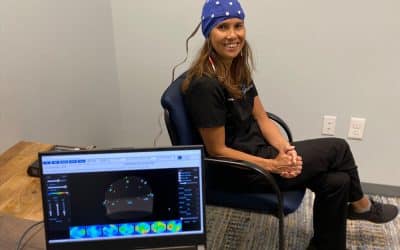The effects of hyperbaric oxygen (HBO2) on eye movement abnormalities in 60 military servicemembers with at least one mild traumatic brain injury (TBI) from combat were examined in a single-center, randomized, double-blind, sham-controlled, prospective study at the Naval Medicine Operational Training Center. During the 10 wk of the study, each subject was delivered a series of 40, once a day, hyperbaric chamber compressions at a pressure of 2.0 atmospheres absolute (ATA). At each session, subjects breathed one of three preassigned oxygen fractions (10.5%, 75%, or 100%) for 1 h, resulting in an oxygen exposure equivalent to breathing either surface air, 100% oxygen at 1.5 ATA, or 100% oxygen at 2.0 ATA, respectively. Using a standardized, validated, computerized eye tracking protocol, fixation, saccades, and smooth pursuit eye movements were measured just prior to intervention and immediately postintervention. Between and within groups testing of pre- and postintervention means revealed no significant differences on eye movement abnormalities and no significant main effect for HBO2 at either 1.5 ATA or 2.0 ATA equivalent compared with the sham-control. This study demonstrated that neither 1.5 nor 2.0 ATA equivalent HBO2 had an effect on postconcussive eye movement abnormalities after mild TBI when compared with a sham-control.
Traumatic Brain Injury (TBI)
Hyperbaric Oxygen Therapy (HBOT) Research for Traumatic Brain Injury (TBI).
Repetitive long-term hyperbaric oxygen treatment (HBOT) administered after experimental traumatic brain injury in rats induces significant remyelination and a recovery of sensorimotor function.
Abstract: Cells in the central nervous system rely almost exclusively on aerobic metabolism. Oxygen deprivation, such as injury-associated ischemia, results in detrimental apoptotic and necrotic cell loss. There is evidence that repetitive hyperbaric oxygen therapy...
Silent Epidemic: The Effects of Neurofeedback on Quality-of-Life
Abstract Background: The complex interaction of human, vehicle and environmental factors along with a lack of sustainable preventive programs has contributed to the "silent epidemic" of traumatic brain injuries (TBI). TBI poses a grave threat to the quality-of-life...
Randomized, Sham-Controlled, Feasibility Trial of Hyperbaric Oxygen for Service Members With Postconcussion Syndrome: Cognitive and Psychomotor Outcomes 1 Week Postintervention.
Abstract: Background Mild traumatic brain injury (mTBI) and residual postconcussion syndrome (PCS) are common among combatants of the recent military conflicts in Iraq and Afghanistan. Hyperbaric oxygen (HBO2) is a proposed treatment but has not been rigorously...
Management of sport-related concussion: a review.
Abstract: To systematically review the evidence for rest, treatment, and rehabilitation after sport-related concussion. Nine databases including PubMed, Cochrane Central Register of Controlled Trials, Sport Discus, and Web of Science were searched for studies that...
Hyperbaric oxygen therapy ameliorates local brain metabolism, brain edema and inflammatory response in a blast-induced traumatic brain injury model in rabbits.
Abstract: Many studies suggest that hyperbaric oxygen therapy (HBOT) can provide some clinically curative effects on blast-induced traumatic brain injury (bTBI). The specific mechanism by which this occurs still remains unknown, and no standardized time or course of...
Department of Defense trials for hyperbaric oxygen and TBI: issues of study design and questionable conclusions.
Abstract: Harch, , , , , , , , (). Department of Defense trials for hyperbaric oxygen and TBI: issues of study design and questionable conclusions. Undersea & hyperbaric medicine : journal of the Undersea and Hyperbaric Medical Society, Inc,...
Reply: Department of Defense trials for hyperbaric oxygen and TBI: issues of study design and questionable conclusions.
Abstract: Weaver, Cifu, Hart, Wolf, Miller, , , , (). Reply: Department of Defense trials for hyperbaric oxygen and TBI: issues of study design and questionable conclusions. Undersea & hyperbaric medicine : journal of the Undersea and Hyperbaric Medical Society, Inc,...
Regulatory considerations for a traumatic brain injury (TBI) indication for hyperbaric oxygen (HBO2).
Abstract: Weaver, Dicks, Deru, Miller, , , , , (). Regulatory considerations for a traumatic brain injury (TBI) indication for hyperbaric oxygen (HBO2). Undersea & hyperbaric medicine : journal of the Undersea and Hyperbaric Medical Society, Inc,...

